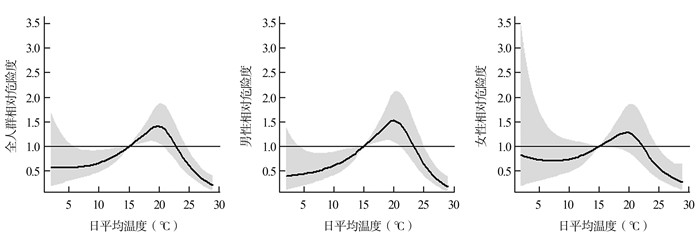Effect of temperature on hand, foot and mouth disease incidence in QuJing: a distributed lag non-linear model analysis
-
摘要:
目的 探究气象因素对曲靖市手足口病(hand, foot, and mouth disease, HFMD)发病的影响及其滞后效应。 方法 采用分布滞后非线性模型(distributed lag non-linear model, DLNM)分析2017-2019年曲靖市气象因素与HFMD发病的相关性及滞后效应。 结果 2017-2019年曲靖市共报告25 902例HFMD,HFMD日发病数与日均气温、降雨量呈正相关,与日照时数呈负相关,以气温对HFMD发病影响最为明显(r=0.51);DLNM拟合结果显示,日均温度20 ℃左右时对HFMD发病的影响最大(RR=1.408, 95% CI: 1.064~1.864, P=0.017);日均温度在无滞后情况下,对HFMD产生的影响最大,随后逐渐降低直至消失。 结论 气温是曲靖市手足口病发病的重要影响因素,其影响有明显的滞后效应;不同温度对不同人群的滞后效应明显不同,高温影响更为显著。 Abstract:Objective To explore the impact of meteorological factors on the incidence of hand-foot-mouth disease (HFMD) in Qujing and its lag effect. Methods The distributed lag non-linear model (DLNM) was used to analyze the delayed and cumulative effects of meteorological factors on incidence of HFMD in Qujing from 2017 to 2019. Results A total of 25 902 HFMD cases were reported in Qujing from 2017 to 2019. The daily number of HFMD cases was positively correlated with daily average temperature and rainfall, but negatively correlated with sunshine duration. Temperature was the most significant effect on the incidence of HFMD (r=0.51); The daily average temperature of about 20 ℃ had the greatest impact on HFMD (RR=1.408, 95% CI: 1.064-1.864, P=0.017); The daily average temperature without delay had the greatest influence on HFMD, and then gradually decreased until disappeared. Conclusions Temperature is an important influencing factor of HFMD in Qujing, and its influence has obvious lag effect. The lag effect of different temperature on different population is obviously different, and the effect of high temperature is more significant. -
表 1 2017-2019年曲靖市手足口病与气象因素分布情况
Table 1. Description of hand, foot, and mouth disease and meteorological factors in Qujing from 2017 to 2019
变量 最小值 P5 P25 M P75 P95 最大值 x±s 手足口病(例) 0.00 4.00 8.00 18.00 30.00 74.00 116.00 23.65±21.05 气温(℃) 1.80 9.00 13.90 18.80 22.90 26.00 29.20 18.23±5.54 相对湿度(%) 26.00 47.00 63.00 75.00 81.00 89.00 100.00 72.06±13.00 降雨量(mm) 0.00 0.00 0.00 0.00 0.80 13.89 106.40 2.62±8.16 日照时数(h) 0.00 0.00 2.30 6.10 8.90 10.80 11.90 5.61±3.62 表 2 2017-2019年曲靖市手足口病日发病数与气象因子间的Spearman等级相关分析结果
Table 2. Spearman correlation between hand, foot, and mouth disease cases and meteorological factors in Qujing from 2017 to 2019
变量 手足口病发病数 平均气温 相对湿度 日照时数 降水量 手足口病发病数 1.00 平均气温 0.51a 1.00 相对湿度 0.02 -0.16a 1.00 日照时数 -0.06b 0.05 -0.73a 1.00 降雨量 0.08b 0.15a 0.55a -0.56a 1.00 注:a:P<0.01;b:P<0.05。 表 3 冷/热效应对手足口病发病风险分析[RR(95% CI)]
Table 3. Risk analysis of cold/heat effect to HFMD [RR(95% CI)]
不同滞
后天数热效应 冷效应 全人群 男性 女性 全人群 男性 女性 lag0 0.914(0.848~0.986)a 0.919(0.842~1.003) 0.907(0.820~1.004) 0.986(0.928~1.047) 1.005(0.936~1.078) 0.958(0.883~1.039) lag1 0.942(0.893~0.992)a 0.951(0.895~1.011) 0.928(0.865~0.996)a 0.998(0.958~1.040) 1.011(0.963~1.060) 0.979(0.926~1.034) lag2 0.963(0.927~1.000)a 0.976(0.933~1.020) 0.945(0.898~0.995)a 1.006(0.977~1.036) 1.014(0.980~1.049) 0.995(0.956~1.035) lag3 0.979(0.947~1.011) 0.993(0.957~1.031) 0.958(0.917~1.001) 1.012(0.986~1.037) 1.015(0.985~1.045) 1.007(0.974~1.042) lag4 0.989(0.958~1.021) 1.005(0.969~1.042) 0.967(0.927~1.009) 1.014(0.988~1.040) 1.013(0.983~1.043) 1.015(0.981~1.051) lag5 0.995(0.963~1.027) 1.011(0.974~1.049) 0.973(0.932~1.016) 1.013(0.987~1.041) 1.009(0.978~1.040) 1.020(0.984~1.057) lag6 0.997(0.965~1.029) 1.012(0.974~1.050) 0.976(0.935~1.020) 1.011(0.984~1.038) 1.003(0.972~1.035) 1.021(0.985~1.059) lag7 0.995(0.964~1.027) 1.008(0.972~1.045) 0.977(0.937~1.019) 1.006(0.980~1.033) 0.997(0.967~1.027) 1.020(0.985~1.057) lag8 0.991(0.962~1.020) 1.001(0.968~1.036) 0.976(0.938~1.015) 1.000(0.976~1.025) 0.989(0.961~1.017) 1.017(0.984~1.051) lag9 0.984(0.958~1.011) 0.992(0.962~1.024) 0.973(0.939~1.010) 0.993(0.971~1.016) 0.981(0.955~1.007) 1.011(0.981~1.043) lag10 0.977(0.952~1.002) 0.982(0.953~1.011) 0.970(0.938~1.004) 0.986(0.964~1.008) 0.972(0.948~0.997)a 1.005(0.975~1.035) lag11 0.969(0.945~0.993)a 0.970(0.943~0.998)a 0.966(0.935~0.999)a 0.978(0.957~1.000)a 0.964(0.940~0.990)a 0.997(0.967~1.027) lag12 0.961(0.936~0.986)a 0.959(0.931~0.988)a 0.963(0.930~0.997)a 0.970(0.948~0.993)a 0.957(0.931~0.983)a 0.988(0.958~1.020) lag13 0.953(0.927~0.980)a 0.948(0.919~0.979)a 0.960(0.925~0.996)a 0.963(0.938~0.988)a 0.950(0.922~0.979)a 0.980(0.947~1.014) lag14 0.947(0.920~0.975)a 0.940(0.908~0.972)a 0.958(0.921~0.996)a 0.956(0.931~0.983)a 0.944(0.915~0.975)a 0.972(0.937~1.008) lag15 0.943(0.915~0.972)a 0.933(0.901~0.967)a 0.957(0.919~0.997)a 0.951(0.924~0.979)a 0.940(0.909~0.972)a 0.965(0.929~1.002) lag16 0.942(0.914~0.971)a 0.930(0.897~0.963)a 0.959(0.920~0.999)a 0.947(0.921~0.974)a 0.938(0.907~0.969)a 0.958(0.923~0.995)a lag17 0.944(0.916~0.972)a 0.930(0.899~0.963)a 0.963(0.926~1.002) 0.945(0.920~0.972)a 0.937(0.908~0.968)a 0.954(0.919~0.989)a lag18 0.950(0.922~0.978)a 0.935(0.904~0.968)a 0.970(0.932~1.010) 0.945(0.920~0.972)a 0.940(0.910~0.970)a 0.951(0.916~0.987)a lag19 0.960(0.928~0.993)a 0.946(0.909~0.984)a 0.981(0.937~1.027) 0.948(0.918~0.979)a 0.944(0.910~0.981)a 0.950(0.910~0.992)a lag20 0.976(0.932~1.022) 0.963(0.913~1.016) 0.996(0.936~1.060) 0.954(0.913~0.997)a 0.953(0.905~1.003) 0.952(0.898~1.010) lag21 0.999(0.934~1.067) 0.987(0.914~1.067) 1.016(0.929~1.112) 0.963(0.903~1.026) 0.964(0.895~1.038) 0.957(0.879~1.043) 注:冷效应:9℃,热效应:26℃;a:P<0.05。 表 4 不同温度、不同滞后时间对手足口病发病数影响的累积滞后效应[RR(95% CI)]
Table 4. Cumulative RR value and its 95% CI of different temperature for daily cases of HFMD at different lag times [RR(95% CI)]]
气温
(℃)滞后
时间(d)全人群 男性 女性 P5=9 0 0.986(0.928~1.047) 1.005(0.936~1.078) 0.958(0.883~1.039) 0~3 1.001(0.868~1.155) 1.045(0.883~1.235) 0.939(0.775~1.137) 0~5 1.029(0.872~1.213) 1.067(0.880~1.294) 0.972(0.780~1.213) 0~7 1.046(0.868~1.260) 1.067(0.858~1.326) 1.013(0.790~1.300) 0~14 0.896(0.687~1.167) 0.833(0.611~1.135) 0.982(0.690~1.399) 0~21 0.628(0.432~0.912)a 0.561(0.362~0.869)a 0.713(0.433~1.175) P25=14 0 0.992(0.979~1.005) 0.997(0.982~1.012) 0.984(0.967~1.002) 0~3 0.987(0.957~1.017) 0.997(0.962~1.034) 0.971(0.932~1.012) 0~5 0.991(0.957~1.026) 1.000(0.960~1.042) 0.978(0.934~1.025) 0~7 0.996(0.957~1.035) 1.000(0.956~1.047) 0.989(0.939~1.042) 0~14 0.976(0.924~1.030) 0.966(0.907~1.030) 0.990(0.921~1.065) 0~21 0.909(0.843~0.981)a 0.897(0.821~0.981)a 0.926(0.837~1.024) P75=23 0 0.975(0.912~1.043) 0.981(0.907~1.061) 0.966(0.883~1.057) 0~3 1.010(0.857~1.190) 1.059(0.875~1.282) 0.946(0.759~1.179) 0~5 1.079(0.891~1.306) 1.170(0.937~1.462) 0.964(0.746~1.247) 0~7 1.149(0.927~1.424) 1.285(1.002~1.648)a 0.985(0.738~1.315) 0~14 1.133(0.861~1.493) 1.305(0.948~1.795) 0.934(0.644~1.354) 0~21 0.972(0.681~1.387) 1.065(0.704~1.609) 0.861(0.534~1.390) P95=26 0 0.914(0.848~0.986)a 0.919(0.842~1.003) 0.907(0.820~1.004) 0~3 0.811(0.675~0.975)a 0.847(0.684~1.049) 0.763(0.595~0.977)a 0~5 0.798(0.644~0.989)a 0.860(0.671~1.103) 0.718(0.538~0.958)a 0~7 0.792(0.624~1.005) 0.878(0.665~1.157) 0.685(0.497~0.944)a 0~14 0.633(0.466~0.861)a 0.710(0.497~1.014) 0.540(0.357~0.817)a 0~21 0.472(0.312~0.715)a 0.482(0.297~0.780)a 0.460(0.263~0.804)a 注:a:P<0.05。 -
[1] Xing W, Liao Q, Viboud C, et al. Hand, foot, and mouth disease in China, 2008-12:an epidemiological study[J]. Lancet Infect Dis, 2014, 14(4):308-318. DOI: 10.1016/S1473-3099(13)70342-6. [2] Liu B, Luo L, Yan S, et al. Clinical Features for mild hand, foot and mouth disease in China[J]. PLoS One, 2015, 10(8):e0135503. DOI: 10.1371/journal.pone.0135503. [3] Zheng Y, Yang J, Yu H. Economic burden of hand, foot and mouth disease (HFMD) in China[J]. Value in Health, 2014, 17(3):A232. DOI: 10.1016/j.jval.2014.03.1353. [4] Wong SS, Yip CC, Lau SK, et al. Human enterovirus 71 and hand, foot and Mouth disease[J]. Epidemiol Infect, 2010, 138(8):1071-1089. DOI: 10.1017/S0950268809991555. [5] Lin TY, Twu SJ, Ho MS, et al. Enterovirus 71 outbreaks, Taiwan: occurrence and recognition[J]. Emerg Infect Dis, 2003, 9(3):291-293. DOI: 10.3201/eid0903.020285. [6] Bible JM, Pantelidis P, Chan PKS, et al. Genetic evolution of enterovirus 71: epidemiological and pathological implications[J]. Rev Med Virol, 2007, 17(6):371-379. DOI: 10.1002/rmv.538. [7] Mcminn PC. An overview of the evolution of enterovirus 71 and its clinical and public health significance[J]. FEMS Microbiol Rev, 2002, 26(1):91-107. DOI: 10.1111/j.1574-6976.2002.tb00601.x. [8] Gasparrini A, Armstrong B, Kenward MG. Distributed lag non-linear models[J]. Stat Med, 2010, 29(21):2224-2234. DOI: 10.1002/sim.3940. [9] 杨丝絮.上海市气温和相对湿度对手足口病的影响研究[D].兰州: 兰州大学, 2019.Yang SX. A study on the influence of average temperature and relative humidity on hand, foot, and mouth disease in Shanghai, China[D]. Lanzhou: Lanzhou University, 2019. [10] 别芹芹, 邱冬生, 胡辉, 等.我国手足口病时空分布特征的GIS分析[J].地球信息科学学报, 2010, 12(3):380-384.Bie QQ, Qiu DS, Hu H, et al. Spatial and temporal distribution characteristics of hand-foot-mouth disease in China[J]. Journal of Geo-Information Science, 2010, 12(3):380-384. [11] 傅涛, 叶晓军, 骆淑英, 等. 2008-2016年浙江省义乌市手足口病流行特征研究[J].疾病监测, 2018, 33(1):50-53. DOI: 10.3784/j.issn.1003-9961.2018.01.012.Fu T, Ye XJ, Luo SY, et al. Epidemiological characteristics of hand, foot and mouth disease in Yiwu from 2008 to 2016[J]. Dis Surveillance, 2018, 33(1):50-53. DOI: 10.3784/j.issn.1003-9961.2018.01.012. [12] 陈灿, 王虹玲, 张辉, 等. 2009—2016年浙江省舟山海岛地区手足口病时空聚集性及病原谱变化分析[J].疾病监测, 2018, 33(1):45-49. DOI: 10.3784/j.issn.1003-9961.2018.01.011.Chen C, Wang HL, Zhang H, et al. Spatial temporal clustering and pathogen spectrum change of hand, foot and mouth disease in Zhoushan islands, Zhejiang from 2009 to 2016[J]. Dis Surveillance, 2018, 33(1):45-49. DOI: 10.3784/j.issn.1003-9961.2018.01.011. [13] Huang Y, Deng T, Yu S, et al. Effect of meteorological variables on the incidence of hand, foot, and mouth disease in children: a time-series analysis in Guangzhou, China[J]. BMC Infect Dis, 2013, 13:134. DOI: 10.1186/1471-2334-13-134. [14] Wei J, Hansen A, Liu Q, et al. The effect of meteorological variables on the transmission of hand, foot and mouth disease in four major cities of shanxi province, China: a time series data analysis (2009-2013)[J]. PLoS Negl Trop Dis, 2015, 9(3):e0003572. DOI: 10.1371/journal.pntd.0003572. [15] 徐晓楠, 王金玉, 李盛.嘉峪关市气象因素与手足口病滞后效应研究[J].中国公共卫生管理, 2016, 32(3):312-314. DOI: 10.19568/j.cnki.23-1318.2016.03.008.Xu XN, Wang JY, Li S. Study on lag effect of meteorological factors and Hand-foot-mouth disease in Jiayuguan city[J]. Chin. J of PHM, 2016, 32(3):312-314. DOI: 10.19568/j.cnki.23-1318.2016.03.008. [16] 田辉, 杨培荣, 洲峰, 等.气象因素对手足口病发病影响及预测模型分析[J].中国学校卫生, 2013, 34(4):451-453. DOI: 10.16835/j.cnki.1000-9817.2013.04.024.Tian H, Yang PR, Zhou F, et al. Effect of meteorological conditions on occurrence of hand-foot-mouth disease and the application of prediction model[J]. Chin J Sch Health, 2013, 34(4):451-453. DOI: 10.16835/j.cnki.1000-9817.2013.04.024. [17] Belanger M, Gray-Donald K, O'Loughlin J, et al. Influence of weather conditions and season on physical activity in adolescents[J]. Ann Epidemiol, 2009, 19(3):180-186. DOI: 10.1016/j.annepidem.2008.12.008. [18] Chan EY, Goggins WB, Kim JJ, et al. A study of intracity variation of temperature related mortality and socioeconomic status among the Chinese population in Hong Kong[J]. J Epidemiol Community Health, 2012, 66(4):322-327. DOI: 10.1136/jech.2008.085167. [19] Stafoggia M, Forastiere F, Agostini D, et al. Vulnerability to heat-related mortality: a multicity, population-based, case-crossover analysis[J]. Epidemiology, 2006, 17(3):315-323. DOI: 10.1097/01.ede.0000208477.36665.34. -





 下载:
下载:




